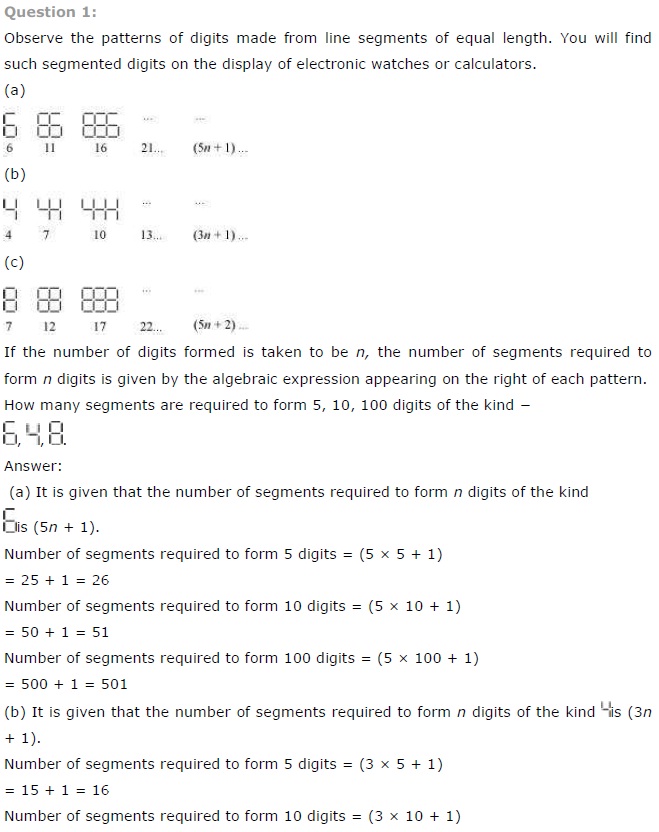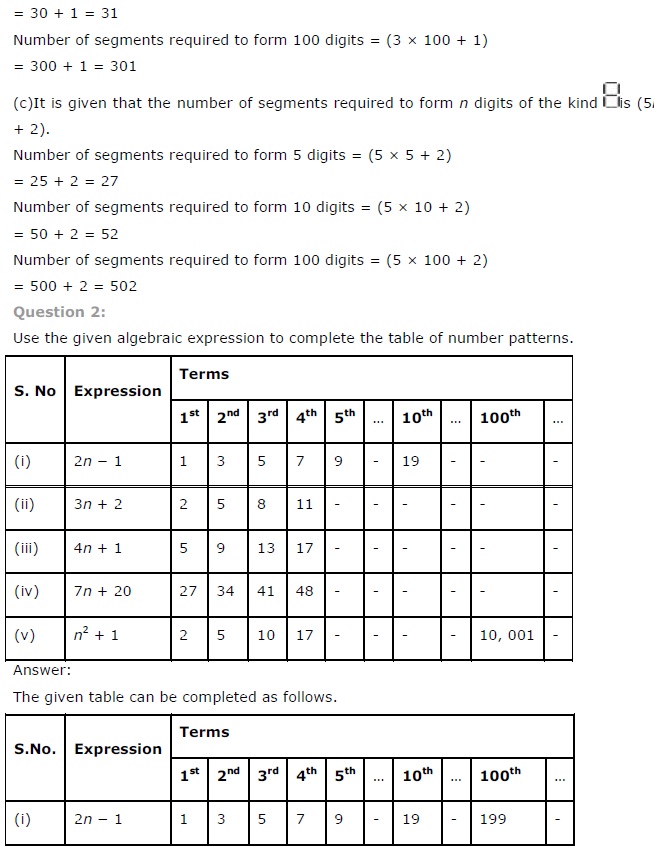NCERT Solutions for Class 7 Maths Chapter 12 Algebraic Expressions
NCERT Solutions for Class 7 Maths Chapter 12 Algebraic Expressions Exercise 12.1
Ex 12.1 Class 7 Maths Question 1.
Get the algebraic expressions in the following cases using variables, constants and arithmetic operations:
(i) Subtraction of z from y.
(ii) One half of the sum of numbers x and y.
(iii) The number z multiplied by itself.
(iv) One-fourth of the product of numbers p and q.
(v) Numbers x and y both squared and added.
(vi) Number 5 added to three times the product of number m and n.
(vii) Product of numbers y and 2 subtracted from 10.
(viii) Sum of numbers a and b subtracted from their product.
Solution:
(i) Subtraction of z from y
Expression: y – z
(ii) One half of the sum of numbers x and y
Expression: 12(x+y) or x+y2
(iii) The number 2 multiplied by itself.
Expression: z × z = z2
(iv) One-fourth of the product of numbers p and q
Expression: 14pq or pq4
(v) Numbers x and y both squared and added
Expression: x2 + y2
(vi) Number 5 added to three times the product of number m and n
Expression: 3mn + 5
(vii) Product of numbers y and z subtracted from 10
Expression: 10 – yz
(viii) Sum of numbers a and 6 subtracted from their product
Expression: Sum = a + b, Product = ab
∴ Required expression
= ab – (a + b)
= ab – a- b
Ex 12.1 Class 7 Maths Question 2.
(i) Identify the terms and their factors in the following expressions show the terms and factors by tree diagrams.
(a) x – 3
(b) 1 + x + x2
(c) y – y3
(d) 5xy2 + 7x2y
(e) -ab + 2b2 – 3a2
Solution:
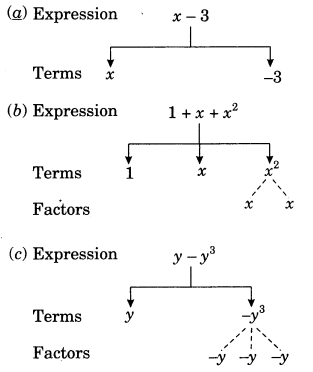
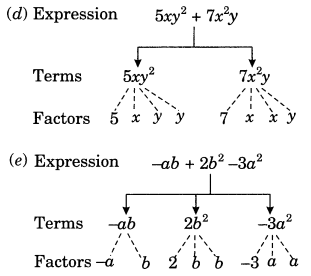
(ii) Identify terms and factors in the expression
given below:
(a) -4x + 5
(b) -4x + 5y
(c) 5y + 3y2
(d) xy + 2x2y2
(e) pq + q
(f) 1.2ab – 2.4b + 3.6a
(g) 34x+14
(h) 0.1p2 + 0.2q2
Solution:

Ex 12.1 Class 7 Maths Question 3.
Identify the numerical coefficients of terms (other than constants) in the following:
(i) 5 – 3t2
(ii) 1 + t + t2 + t3
(iv) 100m + 1000n
(v) -p2q2 + 7pq
(vi) 1.2 a + 0.86
(vii) 3.14r2
(viii) 2(l + b)
(ix) 0.1y + 0.01y2
Solution:
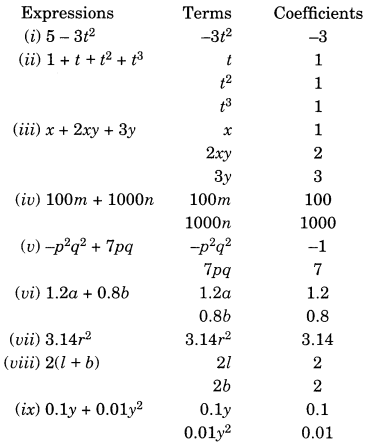
Ex 12.1 Class 7 Maths Question 4.
(a) Identify terms which contain x and give the
coefficient of x.
(i) y2x + y
(ii) 13y2 – 8yx
(iii) x + y + 2
(iv) 5 + z + zx
(v) 1 + x + xy
(vi) 12 xy2 + 25
(vii) 7x + xy2
Solution:
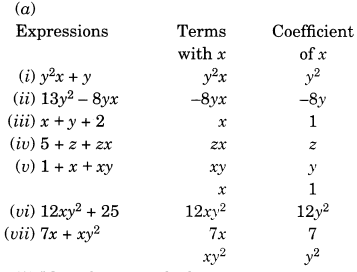
(b) Identify terms which contain y2 and give the coefficients of y2.
(i) 8 – xy2
(ii) 5y2 + 7x
(iii) 2x2y – 15xy2 + 7y2
Solution:
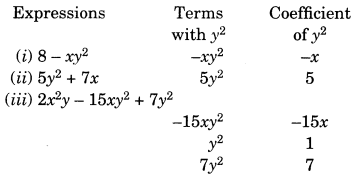
Ex 12.1 Class 7 Maths Question 5.
Classify into monomials, binomials and trinomials:
(i) 4y – 7x
(ii) y2
(iii) x + y – xy
(iv) 100
(v) ab – a – b
(vi) 5 – 3t
(vii) 4p2q – 4pq2
(viii) 7mn
(ix) z2 – 3z + 8
(x) a2 + b2
(xi) z2 + z
(xii) 1 + x + x2
Solution:
(i)4y – 7z – Binomial
(ii) y2 – Monomial
(iii) x + y – xy – Trinomial
(iv) 100 Monomial
(v) ab – a – b – Trinomial
(vi) 5 – 3t – Binomial
(vii) 4p2q – 4pq2 – Binomial
(viii) 7mn – Monomial
(ix) z2 -3z + 8 – Trinomial
(x) a2 + b2 – Binomial
(xi) z2 + z – Binomial
(xii) 1 + x + x2 – Trinomial
Ex 12.1 Class 7 Maths Question 6.
State whether a given pair of terms is of like or unlike terms.
(i) 1, 100
(ii) -7x, 52x
(iii) -29x, -29y
(iv) 14xy, 42yx
(v) 4m2p, 4mp2
(vi) 12xz, 12 x2y2
Solution:
(i) 1, 100 – Like
(ii) -7x, 52x – Like
(iii) -29x, -29y – Unlike
(iv) 14xy, 42yx – Like
(v) 4m2p, 4mp2 – Unlike
(vi) 12xz, 12x2z2 – Unlike
Ex 12.1 Class 7 Maths Question 7.
Identify like terms in the following:
(a)-xy2, -4yx2, 8x2, 2xy2, 7y2, -11x2, -100x, -11yx, 20x2y, -6x2, y, 2xy, 3x
(b) 10pq, 7p, 8q, -p2q2, -7qp, -100q, -23, 12q2p2, -5p2, 41, 2405p, 78qp, 13p2q, qp2, 701p2
Solution:
(a) Like terms are:
(i) -xy2, 2xy2
(ii) -4yx2, 20x2y
(iii)8x2, -11x2, -6x2
(iv) 7y, y
(v) -100x, 3x
(vi) -11yx, 2xy
(b) Like terms are:
(i) 10pq, – 7qp, 78qp
(ii) 7p, 2405p
(iii) 8q, -100q
(iv) -p2q2, 12 q2p2
(v) -23, 41
(vi) -5p2, 701p2
(vii) 13p2q, qp2
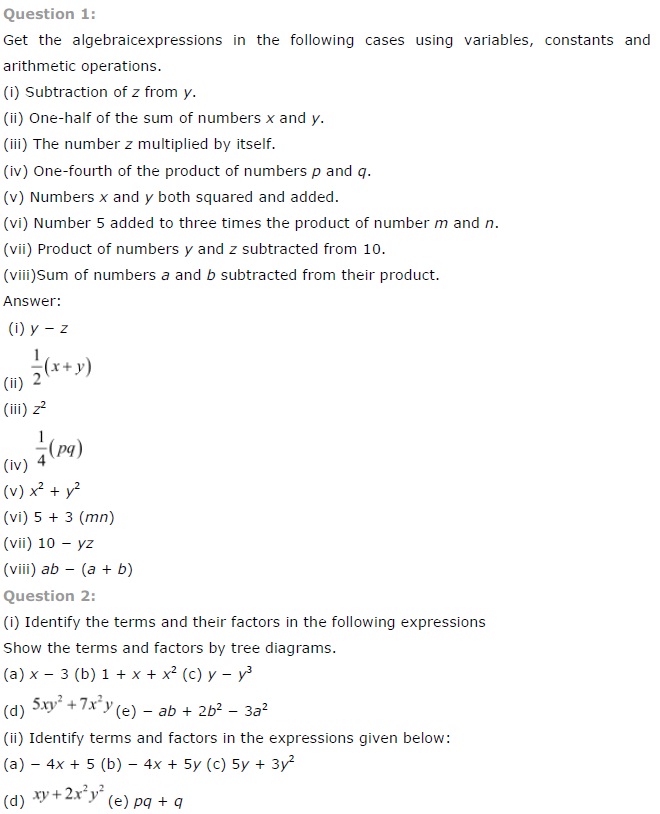
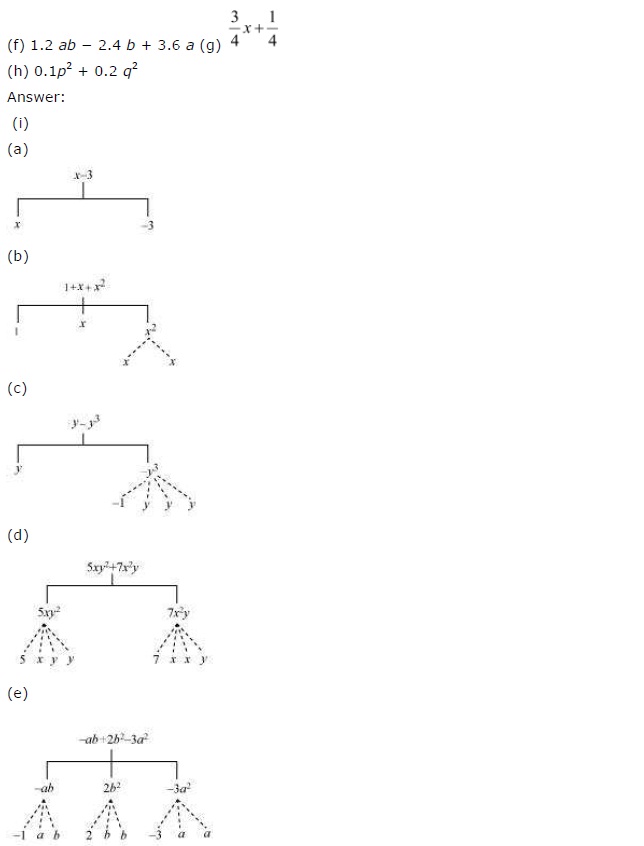

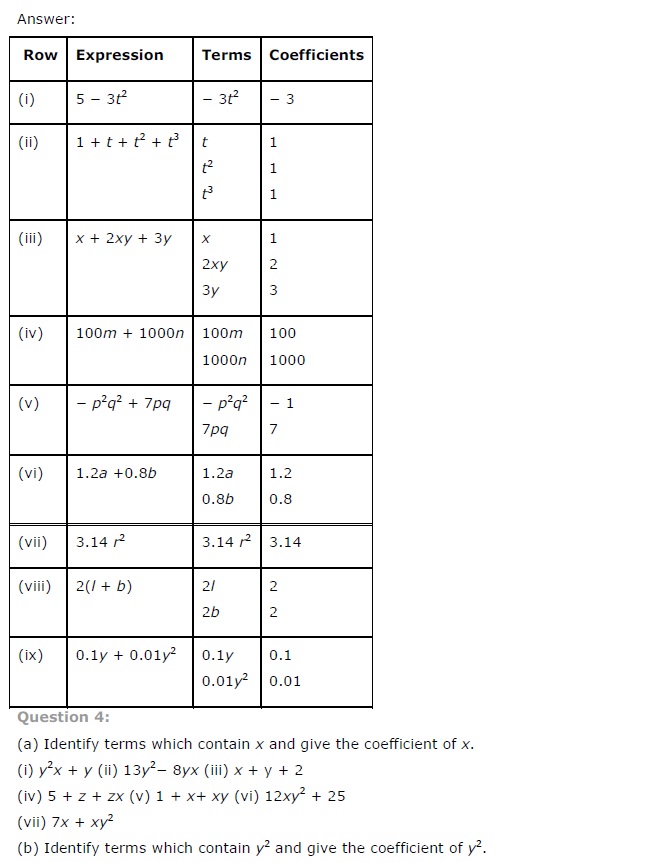
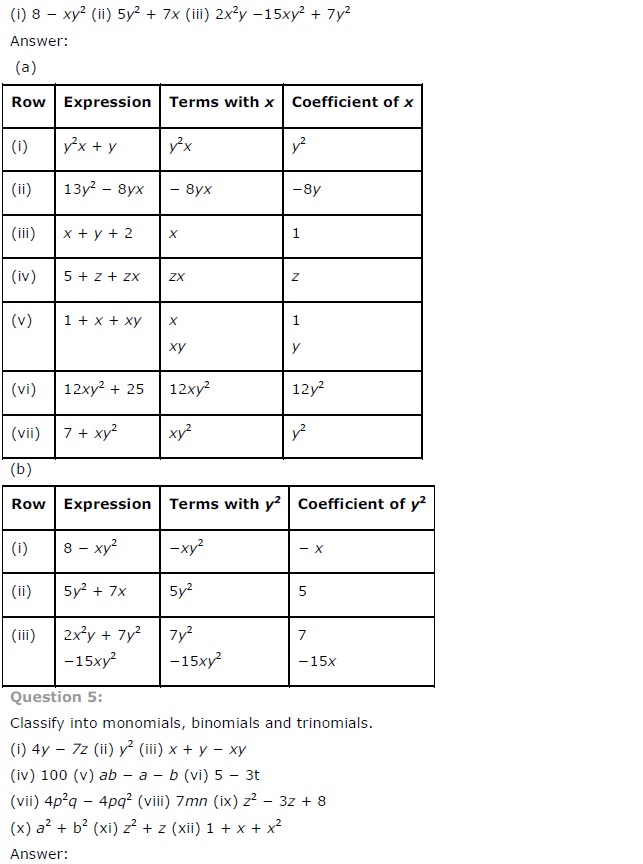
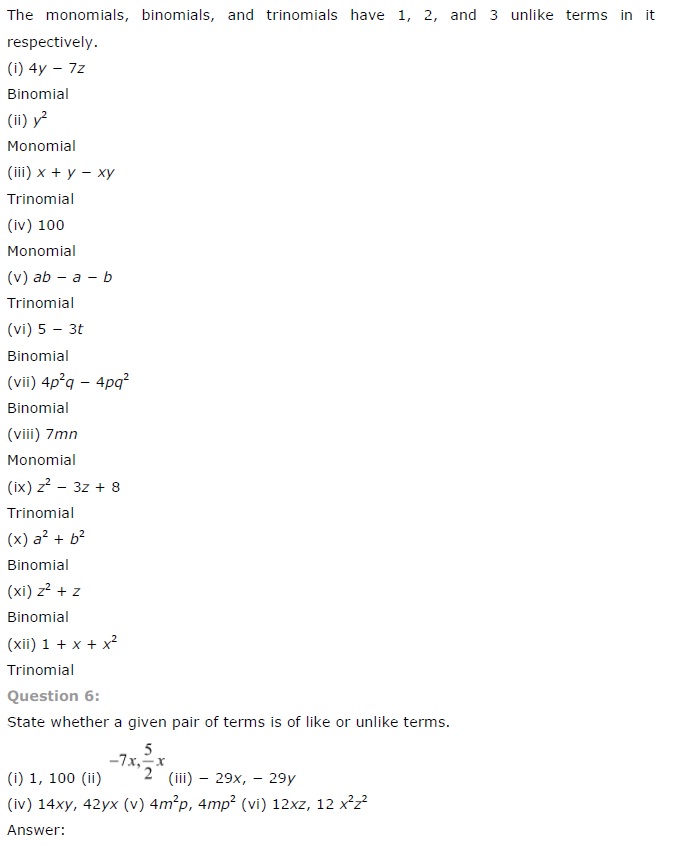
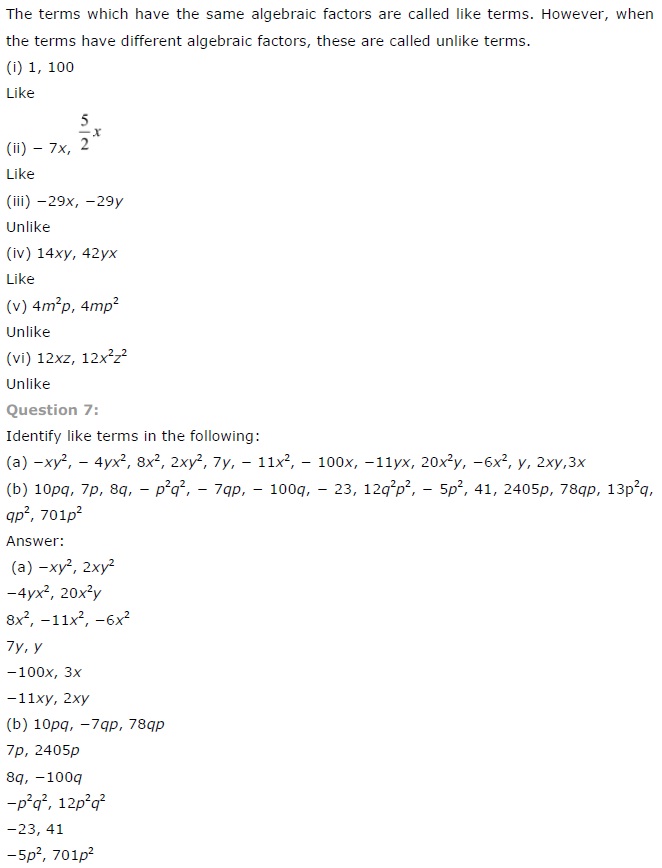
![]()
NCERT Solutions for Class 7 Maths Chapter 12 Algebraic Expressions Exercise 12.2
Ex 12.2 Class 7 Maths Question 1.
Simplify combining like terms:
(i) 21b -32 + 7b- 206
(ii) -z2 + 13z2 -5z + 7z3 – 152
(iii) p – (p – q) – q – (q – p)
(iv) 3a – 2b — ab – (a – b + ab) + 3ab + 6 – a
(v) 5x2y – 5x2 + 3yx2 – 3y2 + x2 – y2 + 8xy2 -3y2
(vi) (3y2 + 5y – 4) – (8y – y2 – 4)
Solution:
(i) 21b – 32 + 7b – 206
Re-arranging the like terms, we get
216 + 7b – 206 – 32
= (21 + 7 – 20)b – 32
= 8b – 32 which is required.
(ii) -z2 + 13z2 – 5z – 15z
Re-arranging the like terms, we get
7z3 – z2 + 13z2 – 5z + 5z – 15z
= 7z3 + (-1 + 13)z2 + (-5 – 15)z
= 7z3 + 12z2 – 20z which is required.
(iii) p – (p – q) – q – (q – p)
=p – p + q – q – q + p
Re-arranging the like terms, we get
![]()
= p – q which is required.
(iv) 3a – 2b – ab – (a – b + ab) + 3ab + b – a
= 3a – 2b – ab – a + b – ab + 3ab + b – a
Re-arranging the like terms, we get
= 3a – a – a – 2b + b + b – ab – ab + 3ab
![]()
= a + ab which is required.
(v) 5x2y – 5x2 + 3yx2 – 3y2 + x2 – y2 + 8xy2 – 3y2
Re-arranging the like terms, we get
5x2y + 3x2y + 8xy2 – 5x2 + x2 – 3y2 – y2 – 3y2
= 8x2y + 8xy2 – 4x2 – 7y2 which is required.
(vi) (3y2 + 5y – 4) – (8y – y2 – 4)
= 3y2 + 5y – 4 – 8y + y2 + 4 (Solving the brackets)
Re-arranging the like terms, we get
= 3y2 + y2 + 5y – 8y – 4 + 4
= 4y2 – 3y which is required.
Ex 12.2 Class 7 Maths Question 2.
Add:
(i) 3mn, -5mn, 8mn, -4mn
(ii) t – 8tz, 3tz, -z, z – t
(iii) -7mn + 5, 12mn + 2, 9mn – 8, -2mn – 3
(iv) a + b – 3, b – a + 3, a – b + 3
(v) 14x + 10y – 12xy – 13, 18 – 7x – 10y + 8xy, 4xy
(vi) 5m – 7n, 3n – 4m + 2, 2m – 3mn – 5
(vii) 4x2y, -3xy2, -5xy2, 5x2y
(viii) 3p2q2 – 4pq + 5, -10p2q2, 15 + 9pq + 7p2q2
(ix) ab – 4a, 4b – ab, 4a – 4b
(x) x2 – y2 – 1, y2 – 1 – x2, 1 – x2 – y2
Solution:
(i) 3mn, -5mn, 8mn, -4mn
= (3 mn) + (-5 mn) + (8 mn) + (- 4 mn)
= (3 – 5 + 8 – 4)mn
= 2mn which is required.
(ii) t – 8tz, 3tz – z, z – t
t – 8tz + 3tz – z + z – t
Re-arranging the like terms, we get
t – t – 8tz + 3tz – z + z
⇒ 0 – 5 tz + 0
⇒ -5tz which is required.
(iii) -7mn + 5, 12mn + 2, 9mn – 8, -2mn – 3
= -7mn + 5 + 12mn + 2 + 9mn – 8 + (-2mn) – 3
Re-arranging the like terms, we get
-7mn + 12 mn + 9mn – 2 mn + 5 + 2 – 8 – 3
![]()
= 12 mn – 4 which is required.
(iv) a + b – 3, b – a + 3, a – b + 3
⇒ a + b – 3 + b – a + 3 + a – b + 3
Re-arranging the like terms, we get
a – a + a + b + b – b – 3 + 3 + 3
⇒ a + b + 3 which is required.
(v) 14x + 10y – 12xy – 13, 18 – 7x – 10y + 8xy, 4xy
∴ 14x + 14y – 12xy – 13 + 18 – 7x – 10y + 8xy + 4xy
Re-arranging the like terms, we get
-12xy + 8xy + 4xy + 14x – 7x + 10y – 10y – 13 + 18
![]()
= 0 + 7x + 0 + 5
= 7x + 5 which is required
(vi) 5m – 7n, 3n – 4m + 2, 2m – 3mn – 5 5m -In + 3n — 4m + 2 + 2m – 3mn – 5
Re-arranging the like terms, we get
5m – 4m + 2m – 7n + 3n- 3mn + 2 – 5
= 3m – 4n – 3mn – 3 which is required.
(vii) 4x2y, -3xy2, -5xy2, 5x2y
Re-arranging the like terms and adding, we get
4x2y – 5xy2 – 3xy2 + 5x2y
=9x2y — 8xy2 which is required.
(viii) 3p2q2 – 4pq + 5, -10p2q2, 15 + 9pq + 7p2q2
= (3p2q2 – 4pq + 5) + (-10p2q2) + (15 + 9pq + 7p2q2)
= 3p2q2 – 4pq + 5 – 10p2q2 + (15 + 9pq + 7p2q2 )
= 3p2q2 + 7p2q2 – 10p2q2 – 4pq + 9pq + 5 + 15
= 10p2q2 – 10p2q2 + 5pq + 20
= 0 + 5pq + 20
= 5pq + 20 which is required.
(ix) ab – 4a, 4b – ab, 4a – 4b
= ab – 4a + 4b – ab + 4a – 4b
![]()
= 0 + 0 + 0 = 0 which is required.
(x) x2 – y2 – 1, y2 – 1 – x2, 1 – x2 – y2
= x2 – y2 – 1 + y2 – 1 – x2 + 1 – x2 – y2
![]()
= -x2 – y2 – 1
= -(x2 + y2 + 1) which is required.
Ex 12.2 Class 7 Maths Question 3.
Subtract:
(i) -5y2 from y2
(ii) 6xy from -12xy
(iii) (a – b) from (a + b)
(iv) a(b – 5) from b(5 – a)
(v) -m2 + 5mn from 4m2 – 3mn + 8
(vi) -x2 + 10x – 5 from 5x – 10
(vii) 5a2 – 7ab + 5b2 from 3ab – 2a2 – 2b2
(viii) 4pq – 5q2 – 3p2 from 5p2 + 3q2 – pq
Solution:
(i) -5y2 from y2 = y2 – (-5y2)
= y2 + 5y2 = 6y2
(ii) 6ry from -12ry = -12xy – 6xy = -18xy which is required.
(iii) (a – b) from (a + b)
= (a + b) – (a – b)
= a + b – a + b = 2b which is required
(iv) a(b – 5) from b(5 – a)
= b(5 – a) – a(b – 5)
= 5b – ab – ab + 5a
= 5a – 2ab + 5b
= 5a + 5b – 2ab which is required.
(v) -m2 + 5mn from 4m2 – 3mn + 8
= (4m2 – 3mn + 8) – (-m2 + 5mn)
= 4m2 – 3mn + 8 + m2 – 5mn
= 4m2 + m2 – 3mn – 5mn + 8
= 5m2 – 8mn + 8 which is required.
(vi) -x2 + 10x – 5 from 5x – 10
= (5x – 10) – (-x2 + 10x – 5)
= 5x – 10 + x2 – 10x + 5
= x2 + 5x – 10x – 10 + 5
= x2 – 5x – 5 which is required.
(vii) 5a2 – 7ab + 5b2 from 3ab – 2a2 – 2b2
= (3ab – 2a2 – 2b2) – (5a2 – 7ab + 5b2)
= 3ab – 2a2 – 2b2 – 5a2 + 7ab – 5b2
= 3ab + 7ab – 2a2 – 5a2 – 2b2 – 5b2
= 10ab – 7a2 – 7b2
which is required.
(viii) 4pq – 5q2 – 3p2 from 5p2 + 3q2 – pq
= (5p2 + 3q2 – pq) – (4pq – 5q2 – 3p2)
= 5p2 + 3q2 – pq – 4pq + 5q2 + 3p2
= 5p2 + 3p2 + 3q2 + 5q2 – pq – 4pq
= 8p2 + 8q2 – 5pq
which is required.
Ex 12.2 Class 7 Maths Question 4.
(a) What should be added to x2 + xy + y2to obtain 2x2 + 3xy?
(b) What should be subtracted from 2a + 8b + 10 to get -3a + 7b + 16?
Solution:
(a) (2x2 + 3xy) – (x2 + xy + y2)
= 2x2 + 3xy – x2 – xy – y2
= 2x2 – x2 + 3xy – xy – y2
= x2 + 2xy – y2 is required expression.
(b) (2a + 8b + 10) – (-3a + 7b + 16)
= 2a + 8b + 10 + 3a – 7b – 16
= 2a + 3a + 8b – 7b + 10 – 16
= 5a + b – 6 is required expression.
Ex 12.2 Class 7 Maths Question 5.
What should be taken away from 3x2 – 4y2 + 5xy + 20 to obtain -x2 – y2 + 6xy + 20?
Solution:
Let A be taken away.
∴ (3x2 – 4y2 + 5 xy + 20)-A
= -x2 – y2 + 6xy + 20
⇒ A = (3x2 – 4y2 + 5xy + 20) – (-x22 – y2 + 6xy + 20)
= 3x2 – 4y2 + 5xy + 20 + x2 + y2 – 6xy – 20
= 3x2 + x2 – 4y2 + y2 + 5xy – 6xy + 20 – 20
= 4x2 – 3y2 – xy is required expression.
Ex 12.2 Class 7 Maths Question 6.
(a) From the sum of 3x – y + 11 and -y – 11, subtract 3x – y – 11.
(b) From the sum of 4 + 3x and 5 – 4x + 2x2, subtract the sum of 3x2 – 5x and -x2 + 2x + 5.
Solution:
(a) Sum of 3x – y + 11 and -y – 11
= (3x – y + 11) + (-y – 11)
= 3x – y + 11 – y – 11
∴ 3x – 2y – (3x – 2y) – (3x – y – 11)
= 3x – 2y – 3x + y + 11
= 3x – 3x – 2y + y + 11
= -y + 11 is required solution.
(b) Sum of (4 + 3x) and (5 – 4x + 2x2)
= 4 + 3x + 5 – 4x + 2x2
= 2x2 – 4x + 3x + 9 = 2x2 – x + 9
Sum of (3x2 – 5x) and (-x2 + 2x + 5)
= (3x2 – 5x) + (-x2 + 2x + 5)
= 3x2 – 5x – x2 + 2x + 5 = 2x2 – 3x + 5
Now (2x2 – x + 9) – (2x2 – 3x + 5)
= 2x2 – x + 9 – 2x2 + 3x – 5
= 2x2 – 2x2 + 3x – x + 4
= 2x + 4 is required expression.
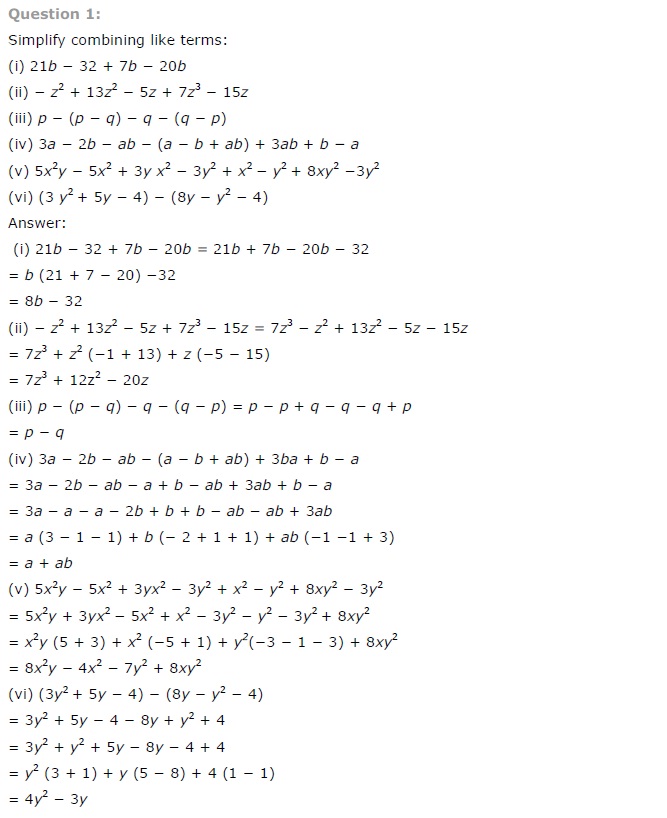
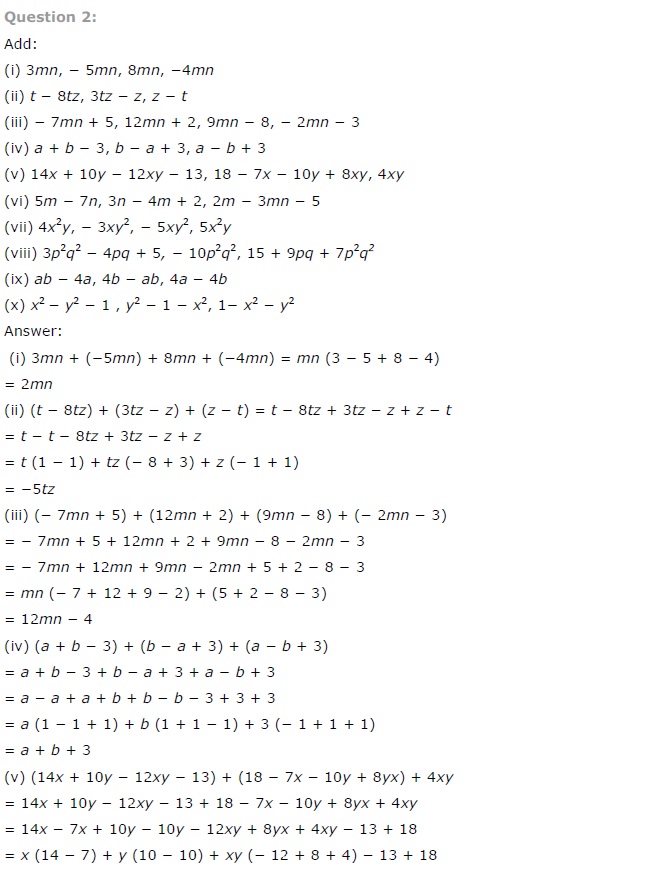
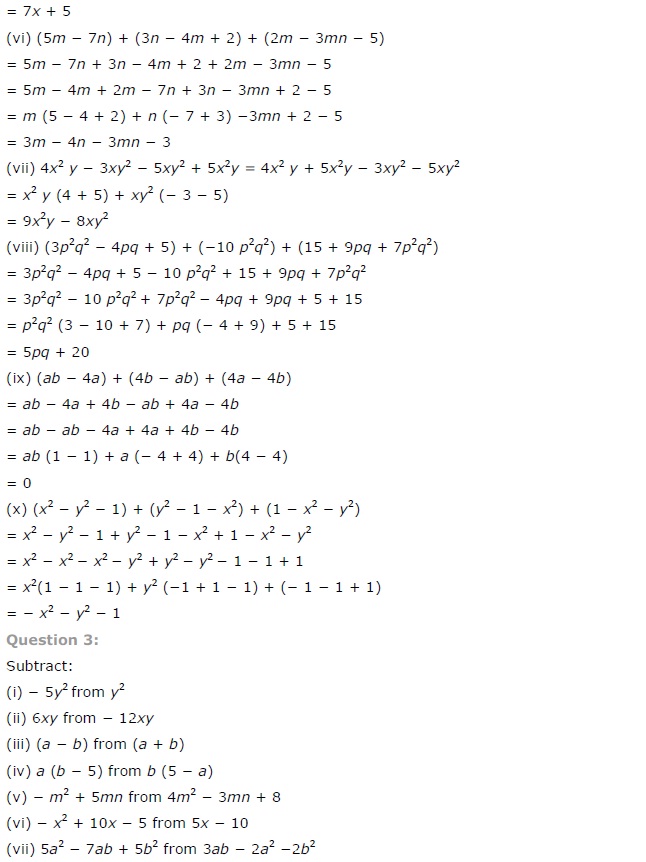
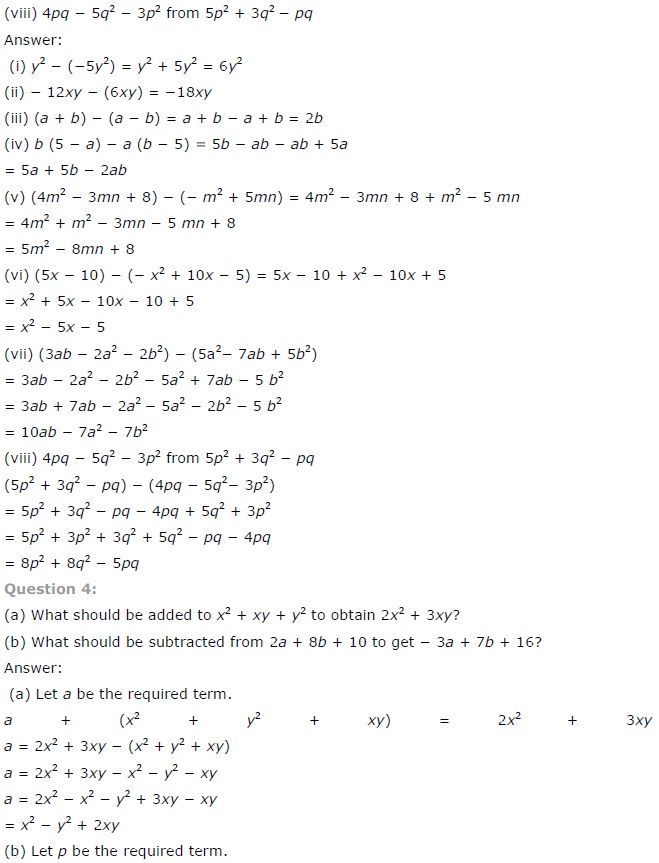
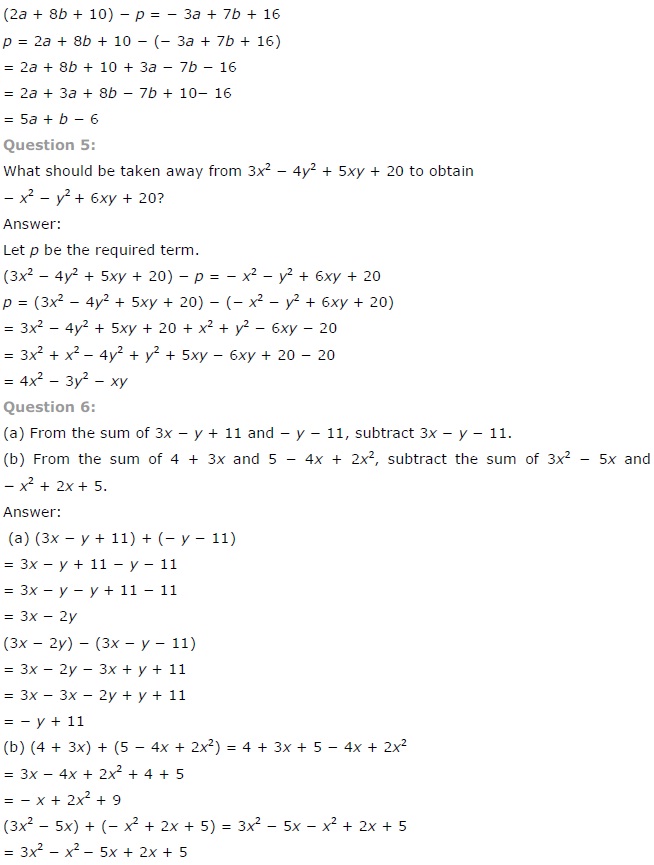

NCERT Solutions for Class 7 Maths Chapter 12 Algebraic Expressions Exercise 12.4
Ex 12.4 Class 7 Maths Question 1.
Observe the patterns of digits made from line segments of equal length. You will find such segmented digits on the display of electronic watches or calculators.
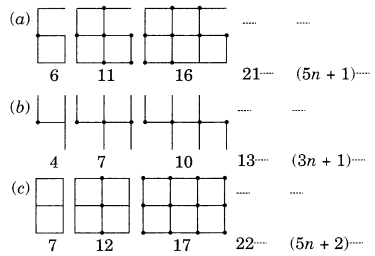
If the number of digits formed is taken to be n, the number of segments required to form n digits is given by the algebraic expression appearing on the right of each pattern. How many segments are required to form 5, 10, 100 digits of the kind 6, 4, 3.
Solution:
(i) The number of line segments required to form
n digits is given by the expressions.
![]()
For 5 figures, the number of line segments = 5 × 5 + 1 = 25 + 1 = 26
For 10 figures, the number of line segments = 5 × 10 + 1
= 50 + 1 = 51
For 100 figures, the number of line segments = 5 × 100 + 1
= 500 + 1 = 501
(ii) ![]()
For 5 figures, the number of line segments =3 ×5 + 1
= 15 + 1 = 16
For 10 figures, the number of line segments = 3 × 10 + 1
= 30 + 1 = 31
For 100 figures, the number of line segments = 3 × 100 + 1
= 300 + 1 = 301
(iii) ![]()
For 5 figures, the number of line numbers = 5 × 5 + 2
= 25 + 2 = 27
For 10 figures, the number of line segments = 5 × 10 + 2
= 50 + 2 = 52
For 100 figures, the number of line segments = 5 × 100 + 2
= 500 + 2 = 502
Ex 12.4 Class 7 Maths Question 2.
Use the given algebraic expression to complete the table of number patterns:
| S.No. | Expression | Terms | |||||||||
| 1st | 2nd | 3rd | 4th | 5th | … | 10th | … | 100th | … | ||
| (i) | 2n – 1 | 1 | 3 | 5 | 7 | 9 | – | 19 | – | – | – |
| (ii) | 3n + 2 | 5 | 8 | 11 | 14 | – | – | – | – | – | – |
| (iii) | 4n + 1 | 5 | 9 | 13 | 17 | – | – | – | – | – | – |
| (iv) | 7n + 20 | 27 | 34 | 41 | 48 | – | – | – | – | – | – |
| (v) | n2 + 1 | 2 | 5 | 10 | 17 | – | – | – | – | 10,001 | – |
Solution:
(i) Given expression is 2n – 1
For n = 100, 2 × 100 – 1
= 200 – 1 = 199
(ii) Given expression is 3n + 2
For n = 5, 3 × 5 + 2 = 15 + 2 = 17
For n = 10, 3 × 10 + 2 = 30 + 2 = 32
For n = 100, 3 × 100 + 2 = 300 + 2 = 302
(iii) Given expression is 4n + 1
For n = 5, 4 × 5 + 1 = 20 + 1 = 21
For n = 10, 4 × 10 + 1 = 40 + 1 = 41
For n = 100, 4 × 100 + 1 = 400 + 1 = 401
(iv) Given expression is 7n + 20
For n = 5, 7 × 5 + 20 = 35 + 20 = 55
For n = 10, 7 × 10 + 20 = 70 + 20 = 90
For n = 100, 7 × 100 + 20 = 700 + 20 = 720
(v) Given expression is n2 + 1
For n = 5, 52 + 1 = 25 + 1 = 26
For n = 10, 102 + 1 = 100 + 1 = 101
